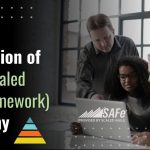Here we answer the question “What does Scaled Agile Framework (SAFe) mean in simpler terms?”. Learn how it helps scale Agile to achieve Business Agility and find out the four levels of the Scaled Agile Framework.
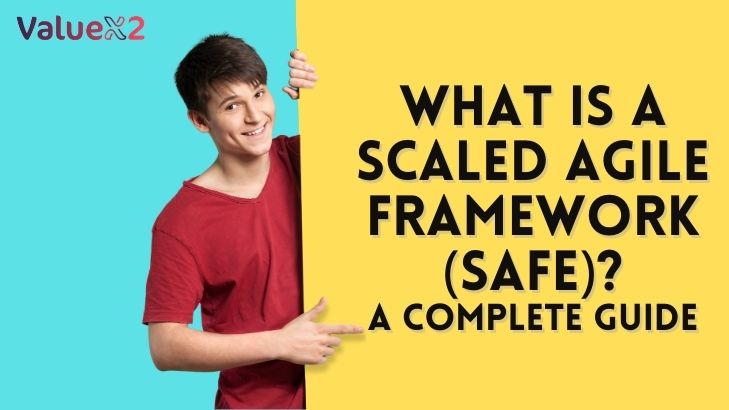
What is the Scaled Agile Framework? What is SAFe?
Often, we get this question from our readers: What is SAFe? Is the Scaled Agile Framework any good? What is the difference between Agile and the Scaled Agile Framework? What is the Scaled Agile Framework?
Today, we will answer all these questions in this in-depth overview of the Scaled Agile Framework.
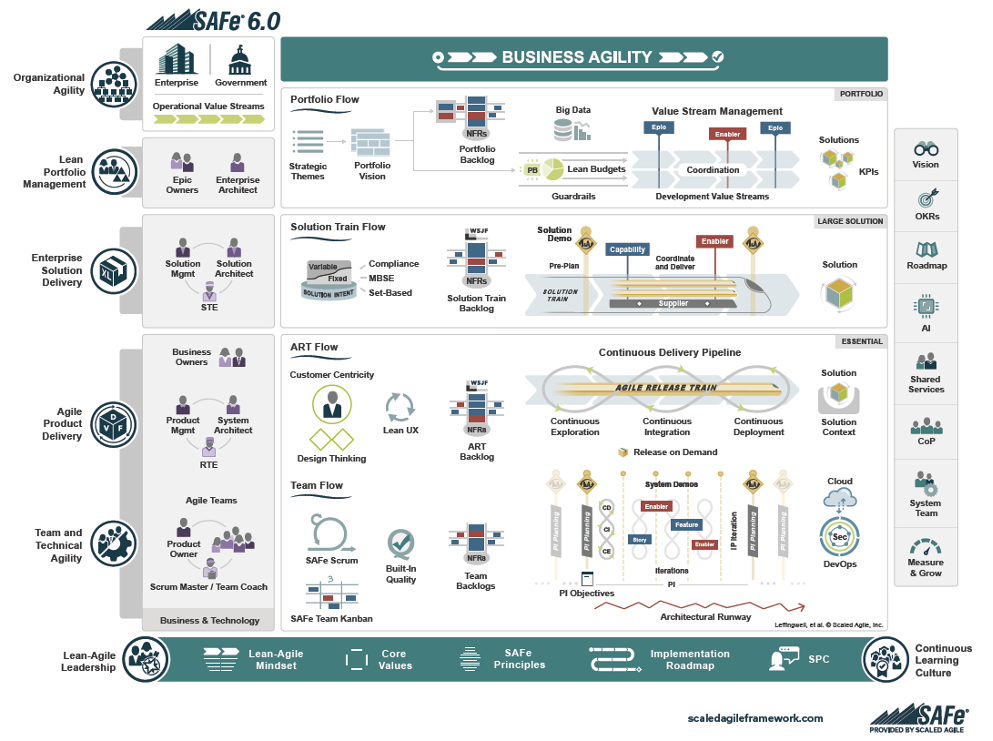
Scaled Agile Framework helps to achieve Business Agility by creating a nimble organization that can quickly react to change, create a culture of happier, motivated people who are more productive, and accelerate speed to value for both customers and the organization. SAFe helps organizations deliver better business outcomes by helping them focus on innovation, customers, and products by acting as a dual operating system.
It is built on leveraging the knowledge bodies of Lean, Agile, Systems Thinking, and DevOps. Scaled Agile Framework is a framework for agile product and service development and management at the enterprise level.
The Scaled Agile Framework is a body of knowledge that incorporates knowledge, ideas, tools, and techniques on things like planning, roles and responsibilities, work management, and agile practices and values.
It utilizes the Scrum Framework at the Agile Team level along with the Lean Business Value Stream approach and Kanban to visualize flow to deliver high-quality products and services faster.
Scaled Agile framework helps large organizations achieve greater agility. It speeds up feedback between stakeholders, leading to increased engagement, productivity, job satisfaction, and faster delivery of better products.
What are the 4 levels of the Scaled Agile Framework?
Given that SAFe is scalable and configurable gives enterprises an option to start implementation from a small team and then scale it to the program and portfolio level. SAFe gives the organization a structured approach for scaling its agile practice to the level that it needs via four different configurations.
The Essential Configuration – This is the basic building block for all SAFe configurations. It operates at the level of a team or a project, or a simple program. It is the simplest starting point for SAFe implementation. It provides the Lean-Agile Leadership competency, the Team and Technical Agility competency, the Continuous Learning Culture competency, and the Agile Product Delivery competency.
The Portfolio Configuration – Provides the Lean Portfolio Management competence, which aligns portfolio execution to company strategy. It organizes development around the flow of value through one or more Value Streams. It introduces governance, strategy, and value stream thinking.
The Large Solution Configuration – Works at the multi-project or multi-program level, which supports those building the largest and most complex solutions that require multiple Agile Release Trains and suppliers, but where there isn’t a consolidated portfolio approach to bringing all the projects and programs together.
The Full Configuration – This integrates all of the above three approaches into a single coherent allowing the enterprise to implement agile at all levels simultaneously in a way that is entirely consistent as you move up and down the levels of the hierarchy from the smallest team and project to the largest portfolio manager. This includes all seven core competencies of the Lean Enterprise. It is the most comprehensive version of the Framework and supports Enterprises that build and maintain a portfolio of large and complex solutions. A detailed explanation of SAFe’s hierarchy provides further insights into these structural elements.
What are the 4 Scaled Agile Framework Core Values?
The Scaled Agile Framework considers the four core values fundamental to its successful implementation to achieve Business Agility.
In the SAFe 6.0 version, the 4 Scaled Agile Core Values were:
- Transparency
- Alignment
- Program Execution
- Built-in Quality
In the latest upgrade to SAFe 6.0, the two core values of Program Execution and Built-in Quality have been replaced.
The 4 Scaled Agile Core Values in SAFe 6.0 are:
- Transparency
- Alignment
- Respect for People
- Relentless Improvement
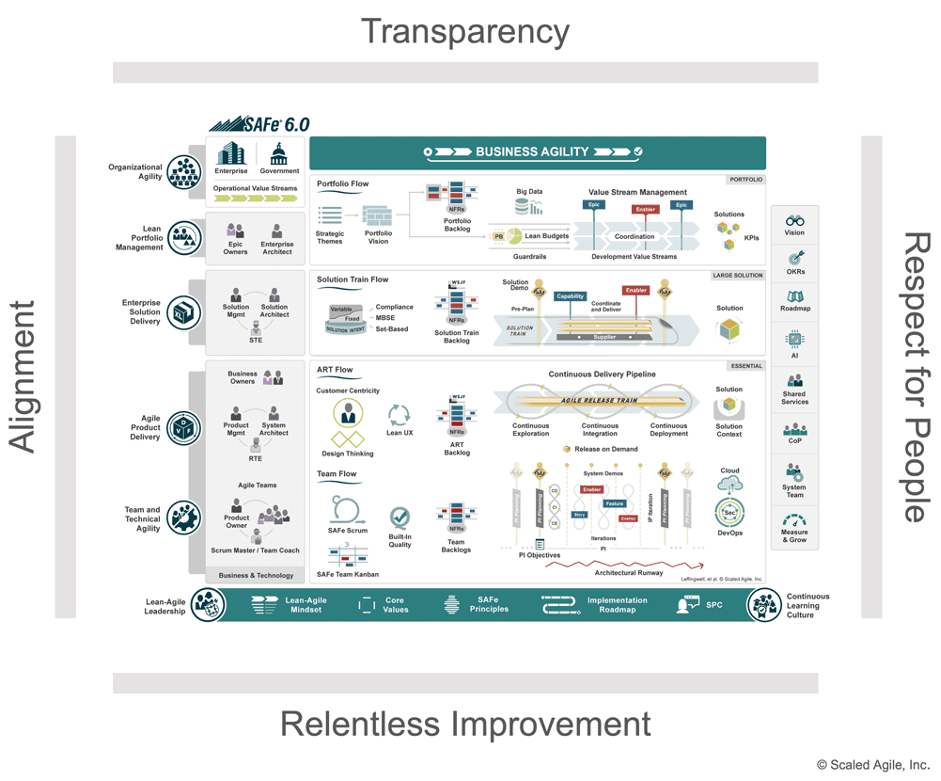
SAFe’s Four Core Values
Transparency: Transparency is required to learn from mistakes and leverage data to develop the solution. To allow for Transparency in an organization, it is important to foster Trust.
Without a culture of transparency and trust, it will be impossible to build high-performing teams and thus fail the new ways of working introduced by SAFe implementation.
Alignment: The idea of the SAFe agile methodology is to reduce time to market and reduce unnecessary distractions. However, if teams and leadership are not aligned and making different decisions, it will hamper value delivery.
Having a connection between strategy and execution with a communicated vision, mission, and strategy is pivotal to bringing alignment in an organization.
Respect for People: Any product and solution development is a team sport, where people do all the work. Respecting people is a basic human need and will allow for highly motivated employees working with creativity, irrespective of the situation.
Valuing diversity of people and opinions, coaching and mentoring employees, and treating internal and external customers with respect and empathy are all ways in which the Scaled Agile Framework promotes Respect for People.
Relentless Improvement: The SAFe Scaled agile methodologies require learning from feedback and being able to pivot when needed. All this requires a culture of Relentless Improvement in a SAFe enterprise.
The only way to embody these 4 core values of the Scaled Agile Framework within the DNA of the company is by having Leaders exemplify them and actively support a Lean-Agile Mindset and culture.
What are the 10 SAFe Scaled Agile Framework Principles?
SAFe Scaled Agile Framework is built on leveraging the knowledge bodies of Lean product development, Agile Values and Principles, Systems Thinking, and observations made from several successful enterprises.
Each company faces its unique challenges, and hence, there is no off-the-shelf solution to solve the problems. This will influence the way we implement SAFe recommended practices, and hence, leveraging the 10 SAFe Scaled Agile Framework Principles will help fundamentally address the problem.
Scaled Agile Framework is based on ten foundational, fundamental Lean-Agile principles. These influence the roles and practices of the SAFe Scaled Agile Framework.
The 10 SAFe Scaled Agile Framework Principles are:
- Take an economic view
- Apply systems thinking
- Assume variability; preserve options
- Build incrementally with fast, integrated learning cycles
- Base milestones on objective evaluation of working systems
- Make value flow without interruptions
- Apply cadence, synchronize with cross-domain planning
- Unlock the intrinsic motivation of knowledge workers
- Decentralize decision-making
- Organize around value
The SAFe Framework: How it Works in Practice?
The Agile Release Train (ART) is the primary value delivery mechanism in SAFe. It is a long-lived, self-organizing team of Agile Teams, a virtual organization of 50-125 people who plan, commit, and execute together. The ART is cross-functional and has all the capabilities like software, hardware, firmware, and more, needed to define, implement, test, deploy, and release value to the customer.
How To Make A Career in SAFe?
A framework is nothing without skilled people. This section is dedicated to the individuals who make SAFe work and how you can become one of them.
SAFe® Roles Explained – Finding Your Place
SAFe defines a clear set of roles to ensure collaboration and accountability. Understanding these is key to navigating a SAFe environment.
- Lean-Agile Leaders: Champion the change and create the environment for success.
- Agile Teams: The powerhouse units, comprised of Scrum Masters (servant leaders) and Product Owners (backlog owners).
- Agile Release Train (ART) Roles:
- Release Train Engineer (RTE): The chief servant leader and coach for the ART.
- Product Management: The internal voice of the customer for the ART.
- System Architect/Engineer: Provides architectural guidance and technical enablement.
- Business Owners: Key stakeholders with ultimate responsibility for the value delivered.
- SAFe Practice Consultant (SPC): Certified change agents who lead the transformation.
To understand where you fit within this organizational structure, a complete guide on SAFe® roles offers comprehensive information.
Which SAFe® Certification is Best For You?
Choosing which SAFe® certification is right is a critical step in advancing your career. Your decision should be based on your current role, experience level, and future aspirations.
- For Leaders & Managers: Leading SAFe® (SA) is the best starting point to understand how to lead a Lean-Agile transformation.
- For Team Members: SAFe® for Teams (SP) teaches you how to be an effective member of an ART.
- For Scrum Masters: SAFe® Scrum Master (SSM) or the SAFe® Advanced Scrum Master (SASM) for experienced practitioners.
- For Product Professionals: SAFe® Product Owner/Product Manager (POPM) is essential for those managing backlogs and representing customer needs.
- For Technical Leaders: SAFe® for Architects (ARCH) focuses on aligning architecture with business value.
- For Transformation Leaders: Implementing SAFe® (SPC) is the premier certification for those who will lead the implementation.
Beyond SAFe® – A Comparative Look at Other Scaling Frameworks
To truly understand SAFe, it’s helpful to see how it compares to other options.
What is the difference between SAFe vs Scrum?
The key difference between Scrum and SAFe Frameworks is that the former helps in achieving team agility, whereas the latter is to achieve enterprise-wide agility, ty i.e., Business Agility.The
Scrum Framework helps in implementing agile product development methodology within small cross-functional teams. It breaks down the project into smaller tasks (incremental development) and then takes feedback from customers regularly to iteratively develop the product.
Scaled Agile Framework, on the other hand, is to scale agile practices across the enterprise using Scrum Teams within Agile Release Trains. This means that not just product teams but all business functions will work together to deliver value.
So to sum up, if you want just a small individual team to use agile methodology for product development, then Scrum Framework is useful; however, if you are building a large, complex product or with multiple teams working together, then SAFe Framework is helpful. SAFe aims at scaling agile principles from individual teams across the entire organization.
What is the difference between SAFe vs. LeSS?
As discussed above SAFe Framework helps scale Scrum practices across the enterprise. Similarly, there are a few other scaling agile frameworks like Large-Scale Scrum (LeSS) and Disciplined Agile (DA).
Having a clear understanding of each of these frameworks will help you choose the best option for your organization.
SAFe: Scaled Agile framework is for enterprises to achieve Business Agility. SAFe incorporates Lean, Agile, and DevOps principles into a comprehensive operating system for companies that helps them succeed in the digital age by delivering innovative solutions faster, more predictably, and with higher customer satisfaction. It is a structured agile framework.
Large Scale Scrum (LeSS): LeSS is Scrum applied to many teams working together on one product. The LeSS framework seeks to apply the principles and ideals of Scrum in a large-scale enterprise context as simply as possible through defined rules and guides.
SAFe vs. Nexus: A Closer Look at Scale and Specialization
In reality, organizations that are using the Nexus Scrum Framework tend to already have a deep commitment to Scrum and, therefore, are using Nexus to attempt to coordinate a few existing Scrum teams to develop a single product. Nexus is viewed as a more nimble approach for managing dependencies and integration issues across teams, but only in a more limited context. In contrast, organizations that use SAFe tend to be a larger enterprise dealing with massive scale, complex value streams, and multiple, varied portfolios, not just a few development teams. Therefore, while Nexus is a scalpel approach for a Scrum-of-Scrums, SAFe is an enterprise operating system that deals with strategic funding, complex solution architecture, and alignment of hundreds or thousands of individuals across independent value streams and business units.
SAFe vs. Disciplined Agile (DA): Flexibility vs. Structure in Practice
Disciplined Agile (DA) tends to be attractive to organizations that want to have high levels of customization and iterative process improvement. In DA, teams can pick and choose from an incredibly detailed toolkit of practices that fit their context, which can motivate great practice, but might also take a lot of internal expertise and discipline to carry out effectively in the absence of common guiding principles. In contrast, SAFe tends to appeal to organizations that want a clear, repeatable, and common approach across a large number of disparate teams and departments. Although it can feel more prescriptive in tactical practices, the structure of SAFe provides a real backbone for better large-scale alignment, common communication rhythms, and coordinated mechanisms for delivering value in the current environment. This can be incredibly important in regulated environments or globally distributed environments where there is an expectation for a clear pathway to success.
SAFe vs. The Spotify “Model”: Lessons from a Case Study vs. A Framework
Many organizations first attempted to take the “ Spotify Model” directly, which was often troublesome because it was an observational case study with no aspiring replicability. They learned after the fact that they could not borrow Spotify’s structure because it was entangled in Spotify’s culture, technology, and continuous change. The “model” described what Spotify did, not a prescriptive model for others. In the case of SAFe, it was specifically designed to be adopted by, and integrated into, other enterprises. It provides a formal, documented set of practices, roles, and events that organizations can implement and configure in a set process. SAFe provides a systematic way to large-scale Agile transformation, supported by workshops, certifications, and a community worldwide, which is a stark difference from how organizations might reverse engineer success based on the cultural journey of a specific company.
Why SAFe?
According to the 17th State of Agile Report, the Scaled Agile Framework (SAFe) is the most popular Scaling Framework. There are more than 20,000 enterprises across various sectors that have leveraged the Scaled Agile Framework to reap its benefits.
SAFe Scaled Agile Framework is the number 1 most considered and adopted framework, as per Gartner. The top 5 benefits of getting SAFe® certified can highlight the value proposition.
Scaled Agile Framework helps companies:
- Transition to agile ways of working
- Respond to the changing competitive landscape and disruptive markets
- Adapt to changing technological trends
- Manage to change customer expectations swiftly
- Adjust to changing market dynamics
- Take advantage of opportunities
Overall, case studies of SAFe implementations show the following benefits:
- Faster time to market
- Better quality products
- Higher productivity
- Better employee engagement
How to implement the Scaled Agile SAFe Framework?
Now that we are aware of all the benefits of SAFe, the next obvious question is how to implement the SAFe Scaled Agile Framework. There are 13 steps that are included in the SAFe Implementation Roadmap that help companies achieve the desired organizational change.
Adopting SAFe is a significant transformation. The SAFe Implementation Roadmap provides a proven 13-step strategy to guide your organization, from reaching the initial “tipping point” to accelerating and sustaining business agility. This journey involves training leaders, organizing around value, launching ARTs, and coaching execution.
For a comprehensive understanding of the implementation process, including common challenges, a guide on SAFe Implementation – Tips and Pitfalls is available. It discusses important IT shifts in scaled agile organizations that often occur during this phase.
There are no two implementations that will be identical, and hence it is important to note that each step should be modified as needed to fit your organizational needs.
The 13 Scaled Agile implementation steps are:
- Reaching the Tipping Point
- Train Lean-Agile Change Agents
- Create a Lean-Agile Centre of Excellence
- Train Executives, Managers, and Leaders
- Lead in the Digital Age
- Organize Around Value
- Create the Implementation Plan
- Prepare for the ART Launch
- Train Teams and Launch ART
- Coach ART Execution
- Launch More ARTs and Value Streams
- Enhance the Portfolio
- Accelerate
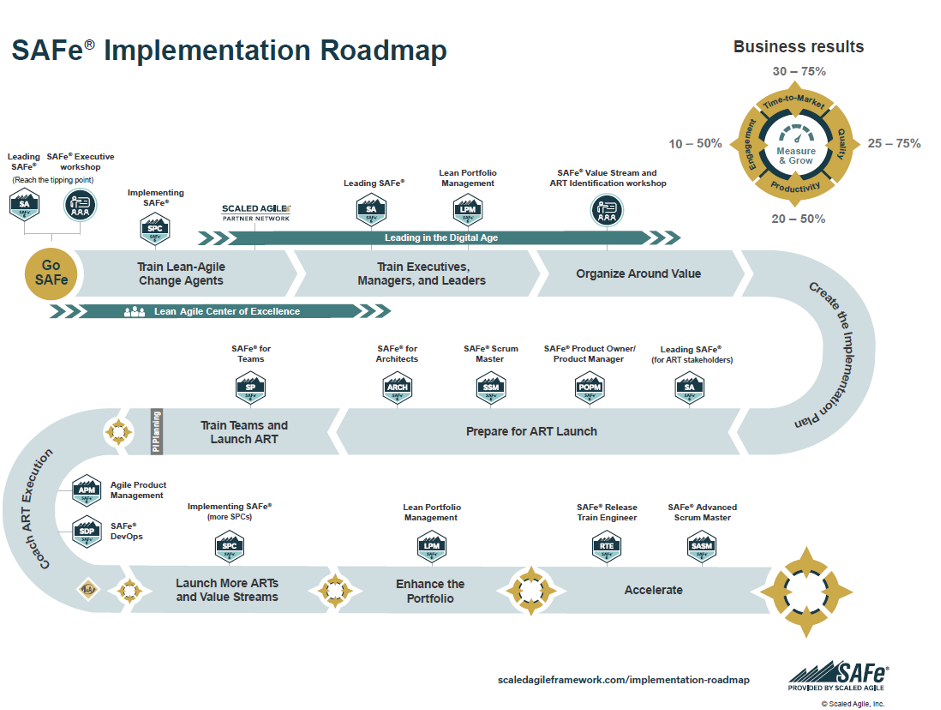
© Scaled Agile, Inc.
What are SAFe certifications?
SAFe certifications are credible certifications when hiring people with demonstrable skills and knowledge. The various SAFe certifications based on roles are:
| Top SAFe Certifications in 2025 | ||
| SAFe Certification Training | Course Overview | SAFe Certification |
| Leading SAFe® (SA) | Thriving in the Digital Age with Business Agility | Certified SAFe® Agilist (SA) |
| SAFe® Product Owner/Product Manager (POPM) | Delivering Value through Effective Planning Interval Execution | Certified SAFe® Product Owner/Product Manager (POPM) |
| SAFe® Scrum Master (SSM) | Applying the Scrum Master Role within a SAFe Enterprise | Certified SAFe® Scrum Master (SSM) |
| SAFe® for Teams (SP) | Establishing Team Agility for Agile Release Trains | Certified SAFe® Practitioner (SP) |
| SAFe® Release Train Engineer (RTE) | Facilitating Lean-Agile Execution from Agile Release Trains | Certified SAFe® Release Train Engineer (RTE) |
| SAFe® Advanced Scrum Master (SASM) | Advancing Scrum Master Servant Leadership with SAFe | Certified SAFe® Advanced Scrum Master (SASM) |
| SAFe® DevOps (SDP) | Optimizing Your Value Stream | Certified SAFe® DevOps Practitioner (SDP) |
| SAFe® for Architects (ARCH) | Architecting for Continuous Value Flow with SAFe | Certified SAFe® Architect (ARCH) |
| Agile Product Management (APM) | Using Design Thinking to Create Value Products in the Lean Enterprise | Certified SAFe® Agile Product Manager (APM) |
| Implementing SAFe® (SPC) | Achieving Business Agility with the Scaled Agile Framework | SAFe Practice Consultant (SPC) |
| Lean Portfolio Management (LPM) | Aligning Strategy with Execution | Certified SAFe® Lean Portfolio Manager |
Your SAFe® Certification Path & Benefits
The SAFe certification path allows for continuous growth, from foundational certifications like SAFe Agilist (SA) to advanced credentials like Release Train Engineer (RTE) and SAFe Practice Consultant (SPC). Earning these certifications validates your skills, makes you highly valuable in the job market, and significantly boosts your earning potential.
SAFe® certification path is easy if you know what to do and when.
Is SAFe certification worth it?
SAFe certifications help boost your salary and advance your career progression options.
According to the SAFe Career Snapshot 2025 report, A SAFe Scrum Master (SSM) on average earns $121,487, which is $4,198 higher than a normal Scrum Master. 67% of the available job postings required SAFe Scrum Master certification.
A SAFe Product Owner (PO) on average earns $129,152, which is $22,152 higher than a normal Product Owner. 42% of the available job postings required demonstrable SAFe experience.
With SAFe Scaled Agile Framework becoming a popular choice globally, SAFe roles are paying higher salaries than alternatives, so speak to ValueX2 to know more and enroll for a SAFe certification Training. ValueX2 is a silver Partner with Scaled Agile Inc.
The Proof – Success Stories of Scaling Agile
The global adoption of SAFe is driven by one thing: results. Companies that properly implement the framework report transformative outcomes.
- Faster Time-to-Market (30-75% improvement)
- Higher Quality (25-75% improvement)
- Increased Productivity (20-50% improvement)
- Better Employee Engagement (10-50% improvement)
These aren’t just numbers; they represent real companies out-innovating their competition and creating more resilient, engaging workplaces.
One prime example of this would be
Philips cut release cycle time from 18 months to 6 months, slashed feature cycle time by 58%, and achieved zero regressions and that all possible because they were applying SAFe across 42 Agile Release Trains (ARTs) . Read the Philips SAFe case study.
For more inspiration, and to see these claims substantiated with real-world examples, you can explore:
- SAFe Case Studies: Discover how various organizations have leveraged SAFe to achieve their business agility goals and report significant improvements across key metrics.
- SAFe Customer Success Stories: Find detailed accounts and testimonials directly from companies discussing their journey and the tangible benefits realized through SAFe adoption.
- SAFe Resources & Whitepapers: Access in-depth articles and whitepapers that often delve into the empirical data and research supporting SAFe’s claimed benefits.
- The SAFe Community Platform: Engage with a global network of SAFe practitioners and access shared experiences and insights into framework implementation and outcomes.
Most Commonly Asked Questions About SAFe
Q: What is the SAFe agile methodology in simple words?
SAFe is essentially a social operating system for aligning human communication inside large, complex organizations. The famous diagrams and processes are secondary to the main goal of creating a rhythmic cadence. It orchestrates high-value conversations among hundreds of people at a predictable and recurring pace. This structured interaction is what truly enables business agility, not just the practice of team-level sprints. The framework’s real product is synchronized understanding across the enterprise, which is a rare commodity.

Bhavna is an Agile Coach and Consultant with 15+ years of experience in advisory, corporate finance, IT assurance, and operations at Big 4 and within the industry in the UK and India. She has recently been the CEO of a start-up where she implemented agile practices within HR, Marketing, and Product teams.
She is also a SAFe® Practice Consultant (SPC) and authorized instructor for ICAgile Agility in HR (ICP-AHR), Agility in Marketing (ICP-MKG), and Business Agility Foundations (ICP – BAF) training courses. She provides training for agile transformation to corporate, public, and private batches, as well as consulting for enterprise agile transformation.

